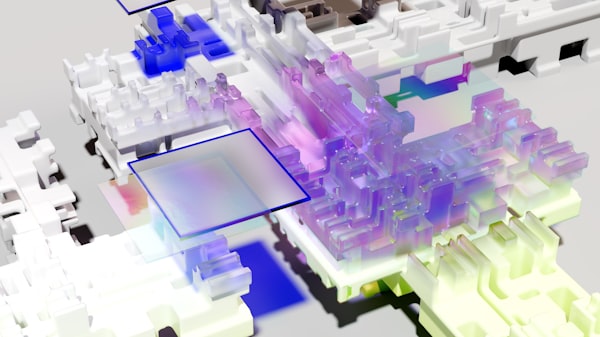1. Understanding Voice-Activated Web Experiences: The Future of Interactivity
Listen, folks, we're about to take a deep dive into voice-activated web experiences. If you're still clicking buttons and typing in search bars, I hate to break it to you, but you're living in the digital equivalent of the Stone Age. The future of interactivity? It's all about chit-chatting with your devices like they're your best buddies. That's right, we're in the realm of the Jetsons now.
Voice-activated web experiences are all about bringing the charm of a great conversationalist to your browsing experience. Siri, Alexa, and Google Assistant started the party, and now it's spreading faster than cute cat videos on the internet. Instead of giving those fingers a workout, why not use that golden voice of yours to surf the web, make purchases, or fill out forms? It's as if you're having a delightful afternoon tea conversation, except your teacup is your laptop or smartphone, and it's ready to dance to the tune of your voice.
The crux of this web revolution is the Speech API - the lovely maître d’ that takes your voice orders and translates them into actions. Imagine a digital butler, suavely saying, 'Your wish is my command.' If the future of interactivity were a concert, voice-activated web experiences would be the headliner. So, stick around, and let's get you front row seats to this fascinating voice revolution!
2. Speech Recognition and Synthesis: The Key Components in Voice Technology
Fasten your seatbelts, tech enthusiasts, because we're venturing into the heart of voice technology - Speech Recognition and Synthesis. These aren't just fancy jargon that tech nerds throw around to sound cool. They are the peanut butter and jelly of the voice-activated sandwich. Let's break it down.
Speech Recognition, or as I like to call it, 'the big eared entity of the digital world', is the miraculous process that allows your devices to understand your dulcet tones. It's the tool that turns your 'Hey, Siri, play Despacito' into actions that your device comprehends and executes. It's like the Babel fish from 'Hitchhiker's Guide to the Galaxy', translating your voice into a language your gadget understands.
Now onto its trusty sidekick, Speech Synthesis. This tech wizard is responsible for making your devices talk back to you. It's the reason Siri doesn't sound like a robot from a 1960's sci-fi flick but more like your friendly neighborhood assistant. Also known as text-to-speech, it's the power that gives your device its unique voice. Imagine Morgan Freeman's voice coming out of your smartphone. Now, wouldn't that be something!
In short, Speech Recognition and Synthesis are the dynamic duo powering voice technology. They turn the dream of interactive, voice-activated web experiences into reality, one command at a time. It's like Batman and Robin, but for your web browser. Welcome to the Batcave, my friends!
3. Exploring the Role of APIs in Voice-Activated Web Design
Now that we've tangoed with the dynamic duo of Speech Recognition and Synthesis, it's time to meet the orchestra conductor of this melodious voice symphony – the almighty API. But what on earth is an API, you ask? Imagine it's a busy waiter at your favorite restaurant, relaying your cravings for 'double cheese pizza with extra olives' to the kitchen, and ensuring the chef gets the order right. API or Application Programming Interface, if you fancy the full mouthful, plays a similar role in voice-activated web design.
APIs for voice activation, such as Google's Web Speech API or Microsoft's Azure Cognitive Speech Services, serve as the bridge between user voice input and the world wide web. They're like diligent interpreters, converting your spoken commands into text and then turning text responses back into speech. It's through their tireless effort that your web applications can understand your midnight craving for 'chocolate chip cookie recipes' or your desperate calls for 'how to fix a flat tire'.
Think of APIs as the unsung heroes of voice-activated web experiences. Without them, voice technology would be like a sports car without an engine, all shiny and promising on the outside but not going anywhere. So here's to the API, the unsung maestro of the voice-activated symphony, making sure every command hits the right note!
4. Harnessing the Power of Speech Recognition for Web Applications
Buckle up, netizens, as we now delve into the vibrant vortex of voice: Speech Recognition. This isn't a Sci-fi movie, though it's just as cool. Think of Speech Recognition as a digital Sherlock Holmes, always listening, always deciphering your commands, ready to swing into action.
Harnessing the power of Speech Recognition for web applications is akin to unlocking a treasure trove of user engagement. It's the secret ingredient that gives your users the convenience of barking orders at their devices rather than typing them. We've all been there - hands deep in pizza dough, desperate to change the playlist, but our doughy fingers deny access to our devices. Enter Speech Recognition, the hands-free savior of our musical needs.
But how do we harness this power? It all starts with integrating APIs like Google's Web Speech API into your web applications. Once you've completed this digital rite of passage, your application is ready to decode the mysteries of spoken language. Remember, it's not just about understanding words; it's about understanding context, dialects, accents, and all those beautiful nuances that make speech... well, human.
In the magical world of web applications, Speech Recognition is your wand, capable of casting enchanting spells of interactivity and engagement. Wave it wisely, and watch as your users revel in the voice-activated wizardry.
5. Boosting Web Accessibility Through Voice-Activated Experiences
Imagine trying to navigate a bustling city without any street signs, and all you have is a paper map from the '80s. Tricky, right? Now, let's take that scenario and apply it to the digital landscape. For many users with disabilities, this can be a reality when browsing the web. But hold onto your hats, dear readers, because voice-activated experiences are here to save the day, Superman-style.
Voice-activated experiences don't just add a splash of convenience to our digital interactions, they play a pivotal role in boosting web accessibility. They're like the digital superpower for individuals who may struggle with traditional input methods due to physical, cognitive, or visual impairments. Talking to your device? It's not just futuristic and trendy; it's inclusive.
This technological superhero opens up the internet world to a whole new user base, breaking barriers faster than a roadrunner on caffeine. Imagine enabling users to fill forms with their voices instead of battling keyboard warriors. Or helping visually impaired individuals browse the web with voice commands. It's like offering a helping hand, ensuring everyone gets to enjoy the digital playground equally.
Voice-activated experiences are boosting web accessibility, one command at a time. It's like a friendly invitation to the grand internet party, making sure nobody is left standing outside the digital disco. So, join us in the celebrations and let your web experiences echo with the sound of inclusivity!
6. The Impact of Voice Technology on User Experience Design
Get ready, design nerds, because voice technology is flipping the script on user experience design, transforming it into a blockbuster hit. It's not just an added feature; it's the director's cut, the highlight reel, the whole enchilada.
Voice technology is changing the way we approach UX design, because let's face it, talking is a whole lot more natural to us humans than clicking, typing or swiping. The result? Web experiences that feel more organic than a kale smoothie.
Imagine, instead of navigating through multiple pages and endless menus, you just say, 'Show me the latest sci-fi movies.' It's like your own genie in a bottle, ready to grant your digital wishes. The simplicity and intuitiveness of voice commands are redefining user experience, making it more seamless than a well-tailored suit.
And then there's the personal touch. Voice technology allows your applications to sound human, almost like they've leaped out of the screen and are having a cozy chat with you. It's this personalized approach that's creating user experiences richer than a triple chocolate cake.
Voice technology is revolutionizing user experience design, taking it from a silent film to a surround sound IMAX experience. It's a new frontier for designers, an opportunity to create web experiences that speak, listen, and most importantly, understand. Get ready to design not just for the eyes, but for the ears and the voice too!
7. Real-World Examples of Effective Voice-Activated Web Experiences
Ladies and gentlemen, it's time to step away from the theory train and hop aboard the practical express. Let's explore some real-world examples of effective voice-activated web experiences that are making waves bigger than a surfer's dream.
First stop, Amazon's Alexa. This digital diva has become the darling of smart homes worldwide, helping users shop, play music, and control their home appliances with voice commands. It's like having your own personal assistant, except she's trapped in a tiny cylinder and doesn't require a coffee break.
Next, we have Google Assistant, a voice-activated virtuoso that's turning smartphones into genies, ready to fulfill your every command. Need directions to the nearest pizza place? Done. Want to send a text message? Easy peasy. This is not your average assistant; it's like having a digital super-agent at your fingertips.
But it's not just about the big tech giants. Innovative startups are also making noise in the voice tech space. Take 'Voiceflow', for instance. They provide a platform for designing, prototyping, and launching voice applications. It's like Adobe Photoshop, but for voice interfaces. Now that's a sound idea!
These real-world examples show that voice-activated web experiences are not just figments of a futurist's imagination. They're here, they're now, and they're speaking volumes about the future of web design. Listen carefully, because the web is starting to talk back!
8. Challenges and Solutions in Implementing Voice-Activated Web Applications
We've serenaded the praises of voice-activated web experiences, but like any great opera, it's not without its dramatic crescendos. There are challenges in implementing voice-activated web applications. But fear not, my tech-savvy comrades, for every challenge, there's a solution waiting to be discovered.
Let's start with a tough cookie: understanding accents and dialects. Oh, the variety of human speech! From the rapid-fire syllables of Spanish to the musical tones of Mandarin, it can be a Herculean task for our digital compadres to keep up. But thanks to machine learning and a constant stream of data, speech recognition engines are getting smarter and more versatile. It's like they're enrolled in a global language course, and they're acing it.
Next up, we have privacy concerns. Nobody wants Big Brother listening in on their heated debate about the best 'Star Wars' movie. To tackle this, developers are turning to techniques like end-to-end encryption and anonymous processing. It's like having a digital bodyguard, ensuring your private conversations remain private.
Then there's the issue of creating engaging voice interactions. A monotonous robotic voice is as appealing as a root canal. However, the advent of Natural Language Processing (NLP) and improvements in text-to-speech synthesis are adding depth and emotion to synthesized voices. They're like digital acting coaches, teaching our voice assistants to sound more human and less like an '80s sci-fi movie robot.
In the world of voice-activated web applications, challenges are just stepping stones on the path to innovation. They may test our mettle, but with every problem we solve, the future of voice technology becomes a little bit brighter. So, let's embrace the challenges and turn up the volume on progress!
9. The Future of Web Design: Integrating Speech Synthesis and Recognition
Look into your crystal ball, fellow digital wizards, and you'll see a future where web design and voice technology are entwined tighter than spaghetti and meatballs. The future of web design? It speaks, listens, and understands. It's all about integrating Speech Synthesis and Recognition.
Picture this: websites that greet you by name, applications that respond to your voice commands, online forms that fill themselves as you dictate the information. No, this isn't a scene from a sci-fi flick. This is the future of web design, a world where voice-activated experiences are as common as hashtags and selfies.
The integration of Speech Synthesis and Recognition means websites and applications that are more accessible, intuitive, and engaging. It's like giving a voice to your favorite book, allowing it to narrate itself while you sit back and enjoy the story.
Imagine search engines that don't just display a list of links but read out the most relevant information. Or how about e-commerce sites where you can order products with a simple voice command? It's like having a personal shopping assistant who's always ready to help, making your online shopping spree smoother than silk.
As we step into the future, web design is evolving from a silent movie to a talkie, from a static canvas to an interactive dialogue. With the integration of Speech Synthesis and Recognition, we're not just designing for the user but also conversing with them. Welcome to the future of web design, where the World Wide Web is ready to chat!
10. Step-by-Step Guide: Designing Your First Voice-Activated Web Experience
Alright, my aspiring voice tech virtuosos, it's time to roll up our sleeves and get our hands digitally dirty. Welcome to your step-by-step guide to designing your first voice-activated web experience. It's like your first cooking class, but instead of whipping up a soufflé, we're cooking up some interactive voice tech.
Step 1: Define your goal. Are you designing a voice-activated shopping assistant? Or maybe a hands-free recipe guide for messy cooks? Knowing your goal is like having a treasure map. It helps you navigate the labyrinth of voice tech with a clear destination in mind.
Step 2: Choose your speech recognition and synthesis APIs. Remember our digital maestro from earlier? This is where you recruit it. Google's Web Speech API and Microsoft's Azure Cognitive Speech Services are both excellent contenders.
Step 3: Craft your voice interactions. What commands will your application respond to? What will it say back? This is your chance to become a digital playwright, creating a dialogue between your users and your web experience.
Step 4: Implement and test. Now comes the fun part. It's like building a Lego masterpiece, piecing together your APIs, voice interactions, and design elements. And once you've got your voice-activated creation, test it out. Get feedback, make tweaks, and test again. It's the digital circle of life.
Step 5: Launch and learn. Congratulations, you've just released your first voice-activated web experience into the wild. But the journey doesn't end here. Monitor user interactions, learn from them, and continue to refine and improve.
Designing your first voice-activated web experience is an adventure filled with challenges, victories, and a whole lot of learning. So, grab your digital toolkit, strap on your explorer's hat, and let's dive into the exciting world of voice tech!








